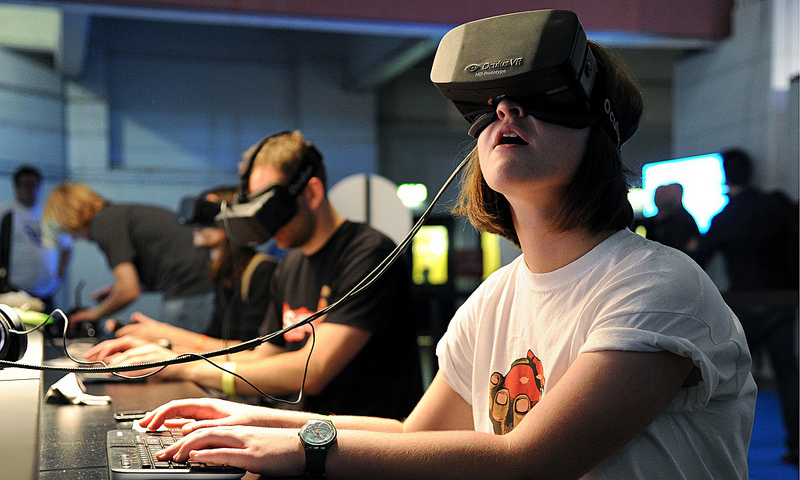 EMERGING TECH
EMERGING TECH
 EMERGING TECH
EMERGING TECH
 EMERGING TECH
EMERGING TECH
In Gartner Inc.’s well-known Hype Cycle for tracking the commercial progress of a technology, the “trough of disillusionment” is the point at which “interest wanes as experiments and implementations fail to deliver.”
That about describes the state of virtual and augmented reality at the moment. On Wednesday, news broke from Business Insider that Facebook is closing some 200 of the 500 “pop-up” demonstration stations inside Best Buy stores for the social network’s Oculus Rift VR hardware. Store personnel reported that after pre-holiday activity, days now go by with no one asking for a demo.
The same day, a source told Business Insider that the augmented reality startup Magic Leap was scrambling to finish a prototype of its AR glasses ahead of a board meeting next week. That follows the revelation last month in The Information reported in December that a prototype of the device shown by Magic Leap Chief Executive Rony Abovitz showed a reporter was hollow, the demo actually provided by a desktop computer. “Sure sounds like a sinking ship,” Wall Street Journal technology columnist Christopher Mims tweeted.
Now, a cluster of setbacks doesn’t mean VR and AR and all the companies developing it are toast. All emerging technologies, including the successful ones, run into the trough of disillusionment, following the “peak of inflated expectations,” which certainly describes the last year or two. It’s still quite likely that VR and AR will eventually reach the next two stages, the “slope of enlightenment” and the exalted if faintly boring “plateau of productivity.”
Several observers suggest that the main problem for these technologies right now is a lack of compelling content. No doubt that is one of the challenges, despite occasional flurries of excitement such as Pokemon Go. “There’s lots of spectacle, but I can’t name one great story in VR,” Ben Miller, now director of VR production at Fox, said in late 2015. That’s probably still the case.
But that content and software isn’t going to get produced if developers don’t think the hardware is going to sell. And right now, it’s clearly not selling in large enough numbers, especially systems such as Oculus’ capable of producing experiences that can really hook people.
That’s the challenge with technology flywheels. When both the hardware and the software are appealing — think Apple Inc. Macs and Photoshop, iPhone and apps — the cycle can get spinning quickly and keep going for many years. But when it hasn’t started turning yet, it’s hard to tell what’s going to get it started.
In the case of VR and AR, it’s pretty clear the hardware isn’t a mass-market phenomenon just yet. Most of the gear so far remains either expensive or underpowered, and people wearing it still look like dorks on drugs.
Even Nabeel Hyatt, a venture partner at Oculus investor Spark Capital, said at a conference in late 2015 that after almost two years of very public testing, Oculus Rift is “still not something my mother would know about if we hadn’t invested. Basically there’s no user base.” And that hasn’t changed yet. Oculus was scarcely mentioned in Facebook’s earnings conference call last week.
Some 46 percent of U.S. adults online don’t know why they would need VR in their lives, and 42 percent haven’t even heard of VR headsets, according to new research from Forrester Research Inc. As a result, Forrester analysts Thomas Husson and Samantha Merlivat believe “critical-mass consumer adoption of high-end VR” is at least five years off.
Ultimately, as Apple showed with the iPhone, hardware and software need to work together seamlessly. “The viewing experience must be clear and detailed with a large field of vision, and the interaction experience must be natural, rich, and immersive,” said Yue Fei, co-founder and chief technology officer of uSens, Inc., an AR and VR company that specializes in hand- and head-tracking technologies. “Realizing that potential depends on perfecting intuitive and reliable 3D human computer interaction. Whether companies achieve this level of the viewing and interactive experiences will determine if consumers opt for VR content over other types of entertainment, including TV consoles and mobile.”
The market issues with VR and AR have led some analysts to throw up their hands. “The market for VR (Virtual Reality)/ AR (Augmented Reality) does not exist,” Global Equities Research analyst Trip Chowdhry wrote in a note to clients Wednesday. “There are only 1 million users who experiment with VR/AR. There is zero customer interest in Oculus. Investors should remove AR/VR and Oculus from their FB investment thesis.”
Even analysts who seem sanguine about the possibilities of VR and AR acknowledge the pieces aren’t all in place. “There’s little doubt the technology is compelling, but the challenge remains to make it more mainstream,” Kevin Krewell, principal analyst with Tirias Research, said in a Forbes post after January’s Consumer Electronics Show. Indeed, one established AR company, Daqri Inc., just laid off a quarter of its 330-person staff after struggling to launch new products, according to Business Insider.
For all that, it’s clear that Facebook as well as other companies working on VR, from Google Inc. to Microsoft Corp. to Sony to Intel Corp., have no intention of slowing down their efforts. Facebook just hired former Xiaomi and Google executive Hugo Barra to take over VR efforts. Google released a flurry of headsets and VR development technologies last year. And Apple Chief Executive Tim Cook said he views AR as a “big idea.”
What’s more, Moore’s Law isn’t dead yet. Successive waves of miniaturization no doubt will produce wearable devices that perform well — maybe sooner than it looks today.
THANK YOU